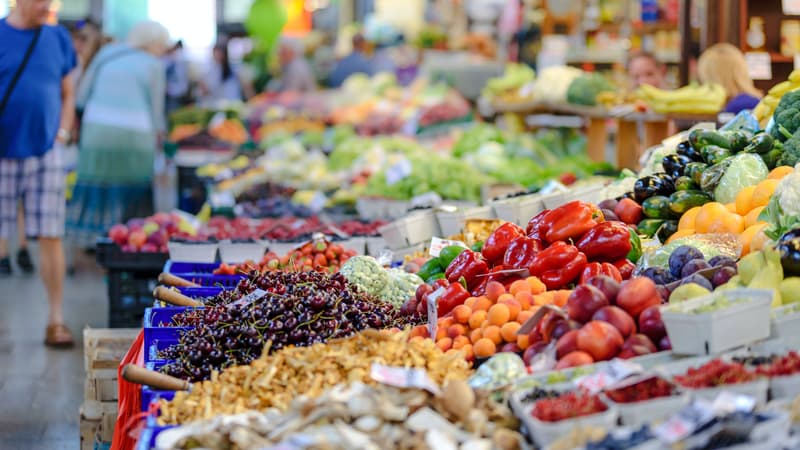The label waltz forgives almost no one. According to a survey carried out by the Banque de France with the CSA* institute, 96% of households said that prices had increased compared to 2021. A year earlier, “only” two-thirds felt inflation and a quarter considered that prices had increased. steady.
It must be said that for several months inflation has been around 6% per year (6.2% today), compared to only 1.6% on average last year. This drives the issue of rising prices and purchasing power to the top of the main concerns of most households, well ahead of climate change, social exclusion and poverty, or unemployment.
Half of the French estimate inflation at more than 7%
Most consumers believe that inflation is, in their eyes, higher than the figure presented by INSEE. However, a finding found “in all survey data, regardless of periods and countries” in which households are asked to estimate the extent of price increases, tempers the Banque de France.
In detail, half of the French believe that inflation is above 7%**. They are also a quarter to judge that it is below 5%, while one in six Frenchmen think, on the contrary, that the rise in consumer prices is at least 20%, and 5% even advance the figure of the 30%. By way of comparison, the average price increase felt in the Eurozone in the second quarter was 12.5%, compared to inflation measured at 8%.
Expectations
In its survey, the Bank of France also analyzed inflation expectations. Or the magnitude of the price increase that consumers expected for the coming months. These expectations play a crucial role for central banks, whose primary mission is to ensure price stability by ensuring that “prices and wages set today do not include expectations of a sustained price increase tomorrow. In such a case, this price increase could be self-sustaining.” , creating an inflationary spiral”, notes the Banque de France.
The results show that the French do not expect a slowdown in inflation in the short term. On the contrary, at the time of the survey, 90% of households foresee a rise in prices in the next twelve months. That is 15 points more than in the same period of the previous year. Its inflation forecast thus stands at an average of 8.6%, while the median of expectations stands at 5%.
As a reminder, the Banque de France expects an increase in consumer prices of 4.7% on average in 2023, but “households form their one-year inflation expectations essentially based on what they receive today,” recalls the institution.
Women perceive higher inflation than men
If each household does not have the same perception of inflation, it is because their sentiments depend on a multitude of criteria. Starting with the income level. As expected, the richest are less sensitive to skyrocketing prices than the most modest. The inflation estimate for households with a monthly income of more than 4,000 euros is, therefore, two percentage points lower than that of households with a monthly income of less than 2,000 euros.
Following the same logic, bac+3 or bac+5 graduates whose remuneration is generally above average perceive a level of inflation 5 points lower than the estimate for non-graduates. Brief or high school graduates have a perception of inflation two points higher than non-graduates. Finally, because they tend to have a more limited budget, young people under 25 years of age estimate inflation at a level around six points higher than that of those over 50 years of age.
The perception of inflation also depends on gender. According to the Banque de France, women, who still tend to do daily shopping more than men today, are more sensitive to price trends. In this sense, the inflation they perceive is two points higher than that felt by their male counterparts.
A perception based on daily purchases
Unlike the INSEE, which measures inflation based on a broad basket of goods and services, households perceive inflation in terms of what they consume the most. “Households extrapolate the evolution of prices that they observe on a daily basis”, sums up the Banque de France. For example, the French who say they buy gasoline (a product that has increased the most in a year up to June 2022) more than once a week perceive global inflation 3 points higher than consumers who never or almost never buy. Clearly, the perception of inflation depends on the structure of consumption.
It should also be noted that a large majority of households perceive the increase in the price of gasoline (75%), fruit and vegetables (90%) or bread (72%) because they are products that are familiar to them. By contrast, almost 12% cannot comment on past price developments for household appliances, compared to only 1-2% for gasoline and food. The Banque de France also points out that households have a similar perception of the evolution of prices for household products and household appliances and clothing, while the former increased by 5% annually in June, compared to +0, 5% of the seconds.
In other words, “it is undoubtedly more difficult to assess the rise in prices of household appliances, the purchase of which is less frequent for households. Conversely, households may overestimate the rise in prices of certain goods that they ‘buy very frequently’. ‘, explain the experts from the Banque de France.
*Survey commissioned by the Banque de France to the CSA institute and carried out among 5,054 residents over 18 years of age surveyed between April 28 and June 11, 2022, when inflation reached 5.6%, already close to 6.2% October.
**weighted median
Source: BFM TV


